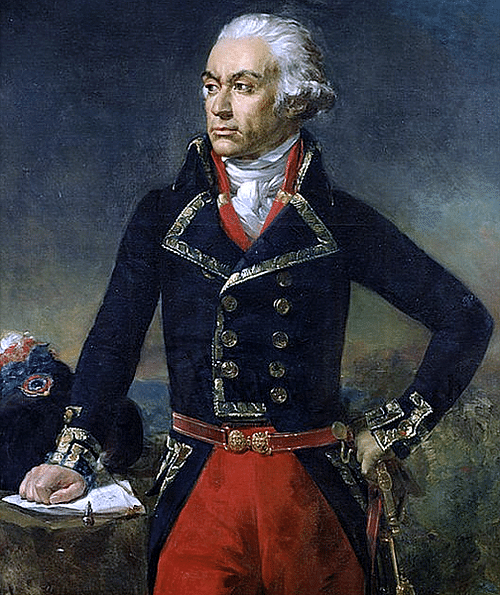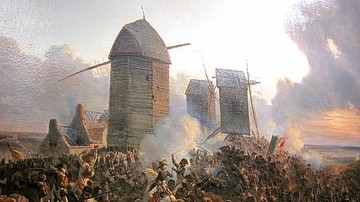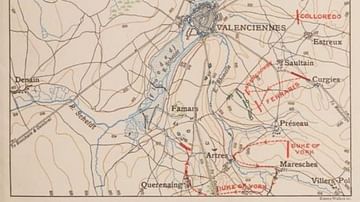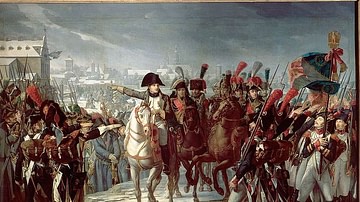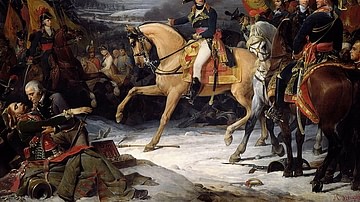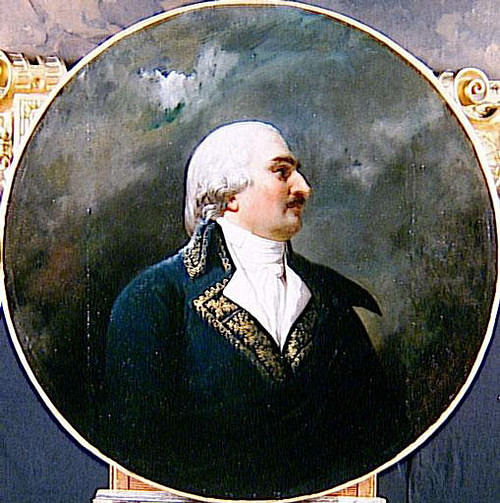
The Battle of Raismes was a major engagement in the Flanders Campaign of 1792-1795, during the War of the First Coalition (1792-1797). It saw a French Republican army under the command of General Dampierre attack a larger Coalition force in a desperate attempt to relieve the siege of Condé. The French were defeated, and the Coalition advanced further into France.
The battle resulted in the death of Dampierre, who had commanded the French Army of the North for only a month, and it caused further setbacks for the undersupplied armies of the French Revolution (1789-1799). Defeats like the one at Raismes would cause Revolutionary France to implement extreme measures like the Reign of Terror in order to defend itself. The battle was also significant for being the first engagement between French and British soldiers during the French Revolutionary Wars (1792-1802) and, by extension, the Napoleonic Wars (1803-1815).
Defeats & Betrayals
By the end of 1792, the citizen armies of the infant French Republic had done much better than most observers had expected. The French Army of the North's decisive victory over a professional Austrian army at the Battle of Jemappes on 6 November had allowed for the conquest of the Austrian Netherlands (Belgium) by the end of the year. Yet the tide of war ebbs and flows; only four months after Jemappes, that one-time conquering army found itself retreating back into France, having suffered the dual blows of defeat at the Battle of Neerwinden on 18 March 1793 and the subsequent defection of its commander, General Charles-Francois Dumouriez, to the enemy side.
Dumouriez, only recently hailed as a heroic defender of France, had become indignant at the rise to power of the extremist Jacobins in Paris. Following his defeat at Neerwinden and his loss of Belgium, Dumouriez had no intention of answering to them; instead, he plotted to turn his army around, march on Paris, and overthrow the Republic's provisional government, the National Convention, perhaps even intending to restore the constitutional monarchy. Unfortunately for him, his soldiers did not much feel like committing treason; on 5 April, Dumouriez and a handful of staff officers were hounded from the French camp, French bullets whizzing past their ears as they rode to the safety of the Austrian army.
In Paris, the National Convention was alarmed to hear that its top general had committed treason at a time when Coalition armies were advancing on all fronts. Fear and paranoia about similar betrayals would cause the Convention to keep their generals on tighter leashes, subjugated to the authority of the Convention's representatives-on-mission. In the coming Reign of Terror, this fear would make defeated generals prime candidates for an appointment with the guillotine. For now, the Convention needed to find a replacement for Dumouriez as commander-in-chief of the all-important Army of the North. They settled on Auguste Marie Henri Picot de Dampierre, a 37-year-old French officer who had proven his loyalty by refusing to join Dumouriez's plot.
Dampierre was the first French commander-in-chief to have reached his position by merit rather than status. Only ten months before, he had been a colonel of the 5th dragoons and had since risen through the ranks by valiantly distinguishing himself at both Jemappes and Neerwinden. From a young age, Dampierre had yearned for military glory. As an officer in the Swiss Guards in the early 1780s, he had deserted his post so he could go to Spain and participate in the Siege of Gibraltar. Unable to return to his regiment, he spent some time in the Kingdom of Prussia where he came to admire the famous military system imposed by King Frederick II the Great; Dampierre enthusiastically adopted Prussian customs and styles of dress. When he returned to France, he was so thoroughly Prussianized that King Louis XVI of France (r. 1774-1792) remarked of him, "Have you seen this lunatic with his Prussian manners?" (Phipps, 173).
Despite his Prussophilia, Dampierre was now determined to beat the Prussians as well as all the other Coalition nations that now threatened his homeland. Given the overall command of the Army of the North and the Army of the Ardennes, Dampierre reoccupied the Camp de Famars near Valenciennes on 15 April 1793. Faced with the daunting task of having to defend a long front, Dampierre was forced to widely disperse his troops. 10,000 men under General d'Harville guarded the French right flank between Maubeuge and Philippeville, while a further 10,000 under Comte de La Marlière sat on the left, entrenched at Cassel. The bulk of Dampierre's force, some 30,000 men, remained with him at Famars while additional men were sent to garrison the fortified towns of Valenciennes, Le Quesnoy, Condé, Dunkirk, and Lille. Outnumbered, ill-trained, and stretched very thin, the French had little choice but to await the Coalition armies, which were bearing down on them.
The Coalition Advances
As Dampierre positioned his troops to defend France, the Coalition army began its slow offensive into France. On 8 April, the Coalition besieged Condé-sur-l'Escaut, a French fortress held by a garrison of 4,300 men. Yet here their advance stalled; the supreme commander of the northern Coalition forces, Prince Josias of Saxe-Coburg-Saalfeld, saw no need to hurry in his offensive. A naturally cautious man, who was reluctant to act without orders from Vienna, Coburg knew that the French armies were undersupplied and stretched thinly across multiple fronts, their coasts menaced by formidable British warships. Time was on his side, and with every day he sat outside the walls of Condé, his numbers swelled.
By 23 April, Coburg commanded some 60,000 soldiers at the blockade of Condé-sur-l'Escaut, representing troops from across the broader Coalition. 6,000 Dutchmen and 3,000 Prussians, under the command of William V, Prince of Orange, guarded the right flank near the towns of Ypres and Menin, while 8,000 Prussians under Field Marshal Alexander von Knobelsdorff held the Scarpe River. Count Clerfayt covered the siege of Condé to the south, commanding 12,000 Austrians who occupied the thick woodlands near the villages of Vicoigne and Raismes. Coburg's main force of 15,000 men besieged Condé itself. Finally, the British, who had only joined the war against France back in February, had landed an expeditionary force at Bruges under the command of Prince Frederick, Duke of York and Albany, the second son of King George III. The British contribution included Hanoverian and Hessian troops as well as British regulars. Coburg's army, poised to invade France, represented the might of Europe's Ancien Regimes, intent on putting the up-jumped French revolutionaries back in their place.

Against this, Dampierre possessed only 30,000 battle-ready troops and was probably reluctant to take the war to the enemy. Yet he was sternly reminded by the National Convention that Condé could not be allowed to fall, and he was forcefully encouraged to go on the attack. The Convention interpreted Dampierre's reluctance as a lack of revolutionary zeal; such an accusation was dangerous in these times, as the threat of the guillotine loomed large. Dampierre knew he had no choice. "Ah," he lamented to one of his officers, "I wish that I could have an arm or a leg carried away, to be able to retire honorably" (Phipps, 179). Such a statement would prove eerily prophetic.
First Attack: 1 May
In accordance with the Convention's wishes, Dampierre moved against the Coalition on 1 May, hoping to seize the initiative. At 4 a.m., he attacked the Coalition line from Saint Saulve to Saint Amand, advancing with one column along the Scheldt River, while a second column was sent against Clerfayt's troops clustered around the towns of Vicoigne and Raismes. Neither attack went well. Outside Saint Saulve, the poorly trained French soldiers were easily swatted away by Austrian troops under the French-born Joseph de Ferraris. Leaning into the momentum of his victory, Ferraris pounced on the French garrison of Valenciennes, which had left its fortifications to aid in the attack. Ambushed, the garrison was decimated, the survivors running, terrified, back behind their city walls.
The second column fared a little better, managing to plant artillery batteries on the heights of Anzin, overlooking Raismes. But as the French artillery bombarded the town, Clerfayt personally led his troops into the surrounding dense woodlands, forcing the French to come to them. Throughout the day, fierce and chaotic fighting raged amongst the trees as the French attacked and were repelled four separate times. Once Clerfayt's tired Austrians were reinforced with fresh Prussian troops, the French called off the attack, and Dampierre pulled his forces back to Famars. He had lost 2,000 men, having gained nothing in return. The Coalition troops, by contrast, had seized several French cannons, one of which was presented to the Duke of York.
Second Attack: 8 May
Back in Famars, the French were licking their wounds when Dampierre received another order from the National Convention. Again, the Convention emphasized the importance of relieving the siege at Condé; again, they ordered Dampierre to attack with all haste. This time, Dampierre decided to concentrate the brunt of his attack on Clerfayt's position around Raismes, having been convinced that the French had almost broken through during their previous attack. On 7 May, Dampierre sent token forces along the Scheldt to keep the rest of the Coalition army distracted, while he led the bulk of his 30,000 men back to Raismes. He began his cannon bombardment of the town that evening.
Coburg had anticipated Dampierre's attack, however. The advance of the French soldiers, heralded by the thunderous roar of their artillery, caused Coburg to send the Duke of York to bolster Clerfayt's position and defend the town of Maulde. York arrived at 6 a.m., before the proper French attack had begun, accompanied by the 10th Hanoverian infantry and three British battalions, including the 2nd British Guards, a unit that would become famously known as the Coldstream Guards. York, who had never before tasted battle, was about to be put to the test.
At 7:30 in the morning, the French attack began. Dampierre himself led the attack on Raismes, in command of eight full battalions. Three times Clerfayt's Austrians fended off the French attack, but they could not withstand the fourth charge, and before long Dampierre was in control of most of Raismes. Meanwhile, another column of French troops under General La Marlière had taken Saint-Amand, which had been abandoned by the Prussians. La Marlière sent a division across the Scarpe River to the forest of Vicoigne; from that vantage, the French began to assemble a gun battery with which they would shell the town of Vicoigne itself, just west of Raismes. The morning attacks had gone well for the French; if they could now just hold their positions, the Coalition host would be forced to break apart, as each national contingent would fall back toward its respective supply base.
Yet fortune would quickly turn against the French. Gathering his men, Dampierre pressed on toward Vicoigne, where the Austrians were still holding out. During the assault, Dampierre was struck in the thigh by a cannonball, causing him to fall. His second-in-command François de Lamarche ordered a withdrawal, noticing that the soldiers had become demoralized.
Charge of the Coldstream Guards
Despite Dampierre's fall and Lamarche's withdrawal, La Marlière still occupied the heights above Vicoigne, threatening the weak point in the Coalition lines between Clerfayt's and Knobelsdorff's divisions. The Austrians and Prussians spent the early afternoon trying to dislodge the French from their positions to no avail. By 5 p.m., hundreds of Austrian soldiers had become casualties trying and failing to take the wooded heights.
It was around this time that the Duke of York arrived on the field, greeted by Prussian General von Knobelsdorff. The general attempted to goad the British into attacking, deliberately minimizing the strength of the French positions and neglecting to mention the casualties the Austrians had suffered in their previous assaults. In broken English, Knobelsdorff explained that he had reserved the final glory of the day for the British Guards, that the redcoats need only show themselves in the wood and the French would flee. Misled and eager to play his part, York lined up the Coldstream Guards and ordered them to advance into the forest of Vicoigne.
The Guards advanced cautiously into the southwest corner of the forest, moving through the thick brush and foliage, stepping over the bodies of fallen Austrians. They approached a glade where three 9-pounder cannons sat awaiting them, as did French light infantry chasseurs. Lieutenant Colonel Lowther Pennington led the charge against the French batteries; the chasseurs' bullets zipped into the British lines, the grapeshot from the cannons felling dozens of men. The Coldstream Guards were forced to pull back into the trees, having sustained 70 casualties.
Although the British attack was repulsed, it had a resounding effect. French General La Marlière, realizing the presence of the redcoats meant that the Coalition had committed fresh reinforcements, decided to cut his losses and withdraw, resulting in a victory for the Coalition. The charge of the British Guards also made an impact on Britain's allies; Gebhard Leberecht von Blücher, who was then a colonel in the Prussian red hussars and was present at the battle, would later write, "I have never seen finer soldiers. They marched with such resolution and did everything possible to attain victory" (Brown, 72). The charge of the Coldstream Guards at Raismes also has the distinction of being the first engagement between British and French soldiers during the French Revolutionary Wars and its continuation, the Napoleonic Wars.
Aftermath & Battle of Famars
On 9 May, Clerfayt and Knobelsdorff stormed the French entrenchments, taking 600 men prisoner. They failed to take any artillery pieces, as the French cannons had been limbered under the cover of night, having withdrawn back to Famars with the rest of the Army of the North. General Dampierre, who had suffered all throughout the night of his grievous thigh injury, died of his wounds later that day. He was buried in a redoubt at Famars, having commanded the Army of the North for only a month. Perhaps it was just as well that he died of his wounds; had he lived, he very likely would have been guillotined for his failures, as he had already fallen under suspicion of being a traitor. His death in the service of the Republic preserved his legacy, and his name is among those inscribed on the Arc de Triomphe in Paris.
The Battle of Raismes was a clear victory for the allies, who had lost somewhere between 600-800 men compared to the 4,000 casualties apparently sustained by the French. The disproportionate number of British losses became a point of friction between the British and the Austrians, with York accusing Knobelsdorff of having tricked him. Some blamed Colonel Pennington for the losses, accusing him of making a foolhardy attack despite observing the strong French positions. Whatever the Duke of York's personal grievances might have been, he never filed an official complaint.
Coburg decided to make the most out of this victory. On 23 May, he attacked the French camp at Famars, defended by 27,000 men under Lamarche, who had assumed command after Dampierre's death. As the French were positioned on two parallel plateaus overlooking the Rhonelle River, Coburg split his army into two columns: the first, commanded by York, would cross the Rhonelle and attack the French right flank. A second column, under General Ferraris, was to attack the French entrenchments on the east bank of the river; this column included Sir Ralph Abercrombie's British brigade.
Although York was initially delayed by a thick fog, both he and Ferraris managed to progress toward the French positions, defeating the French in several preliminary engagements. Fatigued, the allied commanders decided to wait a night before attacking the French positions in earnest. Realizing he was being surrounded, Lamarche used the opportunity to withdraw from Famars. Lamarche's retreat left the road to the fortified town of Valenciennes wide open; Coburg besieged it on 13 June and took it on 28 July. Condé also fell to the besieging allies on 10 July.
This string of victories by the allies alarmed the French. Lamarche was removed from command and replaced by Adam Philippe, Comte de Custine, who himself only lasted three months before being arrested and guillotined by the National Convention, accused of cowardice. Defeats like Raismes also helped lead to the Reign of Terror, which was implemented by Revolutionary France to defend itself from enemies foreign and domestic. Yet the time it took for the sluggish Coalition armies to finish the sieges of Condé and Valenciennes gave the French military valuable time to reorganize itself. The autumn of 1793 would see decisive French victories at the Battle of Hondschoote and the Battle of Wattignies, victories that would revitalize the French war effort and turn the tide of war once again in France's favor.

